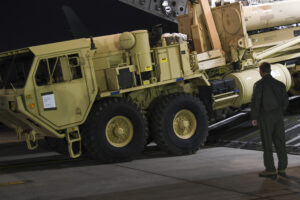THAAD Missile Defenses Deploy To South Korea: How Will North Korea, China React?
Posted on
American THAAD missile defense vehicles landed at Osan, South Korea today after almost eight months of waiting. Now the question is how the North and China react.
Increasingly threatened by North Korean missiles — most recently test-launched just yesterday — the South agreed last July to host the US Army’s Terminal High Altitude Area Defense system. THAAD would provide an additional layer of protection on top of both the Army’s shorter-ranged, lower-altitude Patriot batteries already deployed on the peninsula and the Standard Missiles on Navy Aegis ships offshore. (Pacific Command chief Adm. Harry Harris has argued forcefully for connecting the Army and Navy missile defense networks in his theater).
But THAAD radar’s greater range means batteries in South Korea can potentially detect, not just North Korean missiles, but planes in Chinese airspace. Experts we spoke to in 2015, after Beijing first raised this objection, said it was not a serious threat to China but rather a pretext for throwing wrenches in the US-Korean alliance — but in fact, Chinese pressure had been so heavy-handed it had made Seoul more receptive to THAAD rather than less.

Army THAAD vehicle unloading.
Nevertheless, fear of a backlash from Beijing almost certainly slowed down deployment, with US officials repeatedly saying they were ready to deploy whenever Seoul gave the okay. (The ongoing impeachment of South Korea’s president hasn’t exactly accelerated decision-making, either). Beijing had recently cracked down on imports of South Korean pop culture, and Chinese hackers struck a South Korean conglomerate, Lotte Duty Free, that had transferred land to the government to station THAAD on. On the other hand, Beijing is increasingly frustrated with its protégés in Pyongyang and recently announced it would stop importing North Korea coal, which would be a major blow to the Hermit Kingdom’s economy if actually enforced. With the THAAD deployment underway, China’s prickly nationalism will no doubt demand some stern protest, but it’s hard to say how much bite will be behind the bark.
That leaves North Korea, as predictably unpredictable as ever. The third-generation dictator Kim Jong-un had launched more missile tests in his four-year reign than his father Kim Jong-il did in 18 years. (Grandfather Kim Il-sung had no missiles to launch). His agents assassinated his exiled half-brother in Malaysia last month. But the young tyrant has not sunk South Korean warships, infiltrated mini-subs full of commandoes, or blown up civilian airliners the way his forebears did, either. With luck, he will just bluster and launch more missiles into the sea. Without luck — well, that’s what we have THAAD for.
Correction: The original version of this article stated that THAAD missiles could reach Chinese airspace from launchers in South Korea. In fact, only the THAAD radar has a range that extends so far.
Subscribe to our newsletter
Promotions, new products and sales. Directly to your inbox.
